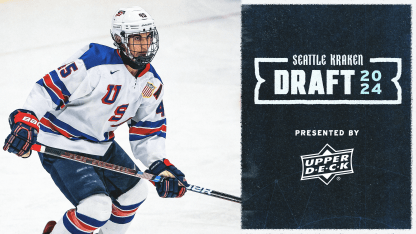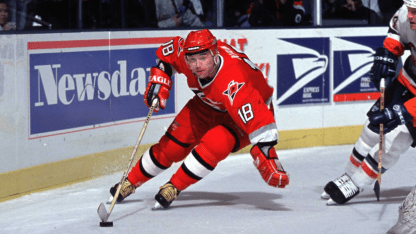While the famed science fiction novelist Jules Verne knew “leagues” as a measurement (three nautical miles) to launch larger-than-life oceanic adventures, Seattle’s amateur scouts dive deep into a whole other and more familiar type of leagues – ones that feature young hockey players embarking on their own exciting adventure.
Verne’s novel, “20,000 Leagues Under the Sea,” dates back to 1870 and more widely popularized the 13th-century Norwegian myth of the Kraken that is now Seattle legend too. The hockey leagues feeding prospects into the National Hockey League have their own long roots, dating back to before the NHL was founded in 1917. Amateur leagues were formed in the Canadian provinces of Ontario, Quebec and Manitoba by 1890, while the first U.S. amateur hockey league dropped its first puck in 1896. Swedish enthusiasts, introduced to the sport in 1920 by American film director and ice hockey coach Raoul Le Mat, formed its first league just two years later. Neighboring Finland followed suit in 1928. Russians formed that country’s first competitive associations in 1946.
Expanding Global Footprint of Prospects
These days, NHL player rosters and prospect pools span across the rinks of North America and Europe, with 34 leagues and 16 different countries generating at least one draft choice in last summer’s 2023 NHL Draft. The Kraken franchise did its part in the game’s globalization, selecting players from Czechia, Denmark, Belarus, Finland and Sweden to go along with five Canadiens. Oscar Fisker Molgaard, Kraken 2023 second-round center, was the only Danish player selected.
The 16 different countries equate to the most since 2004, when it reached 17 countries (in a draft with nearly 70 more overall selections over nine rounds). Fourteen players born outside North America were first-rounders last June, including Kraken top pick (20th overall) and Czechia center Eduard Sale.
Less than a decade ago, half of the NHL’s player base was Canadian. A look at the opening night rosters for the 2023-24 season shows that number was 41.7 percent (295 players), followed by the U.S. at 29.1 percent (206) and Sweden third-highest at 9.1 percent (64). Russia counted 41 NHLers for 5.8 percent, while Finland was 5.1 percent (36).
Other nations with NHL representation included Czechia (3.3 percent/23 players), Switzerland (1.4 percent/10 players), Germany (1.1 percent/eight players), Slovakia (0.8 percent) and Denmark (0.6 percent) filling out the top 10 nations.
It follows that draft choices would track similarly. In 2023, the top five countries supplying draftees were the same top five: Canada (86 players), USA (50), Sweden (24), Russia (19) and Finland (15). Doing the math, comparing the percentages of draft choice by country to NHL rosters reveals Sweden, Russia and Finland all notching up a few percentage points, while Canada dropped to 38 percent of players chosen and USA down to 22 percent.
Taking a Closer Look at Leagues Scouted
The 34 different leagues represented among 2023 draft picks is another indicator that finding future Kraken players is about keeping open minds and creative itineraries to where the team’s amateur scouts might discover teenage prospects with the upsides to develop into NHLers.
While most observers say Russia’s Kontinental Hockey League is Europe’s most competitive pro league. But any number of scouts will contend all of Europe’s pro leagues are rising in developing players good enough to be future NHLers.
“They're all good, right?” said Kraken GM Ron Francis when asked about the caliber of play in the many leagues his scouting staff is traversing. “Sometimes [in Europe’s pro leagues] you’re looking at the kids playing up with the men and how the player is doing versus playing down [for their club’s junior team].
“There are a lot of leagues to look at. You’ve got the KHL, three leagues in Russia [second-tier pro and juniors]. You’ve got two leagues in Sweden and a couple in Finland. Then, the three [major junior] leagues in Canada. There’s the USHL and colleges in the States. Plus, prep schools and secondary/high school teams in both [North America] countries There are leagues in Czechia, Slovakia, Germany, Switzerland, Austria and Denmark that we watch for prospects. All of those leagues are just getting better and better.”
The Challenge of Comparing Leagues
Kraken director of amateur scouting Robert Kron was drafted by Vancouver in the fifth round of the 1985 NHL Draft. He subsequently played three seasons in his native Czechia’s top pro league before joining the Canucks for the 1990-91 season. He played 771 NHL games and has been both director of European scouting with Ron Francis in Carolina and now overseeing all amateur scouts. He credits the Kraken hockey analytics group’s models with helping improve how the team compares players’ performances even when they don’t play in the same league, plus appreciates what his scouts are seeing and reporting.
“Obviously, every league is a little different, even in the CHL with the OHL, ‘Q’ and WHL,” said Robert Kron during a break of the Kraken late-May amateur scouting meetings to finalize the draft board. “We know here in North America, college players are older, and you watch the younger [prospects] in those situations.
“In the European leagues, depending where these prospects play, in the top leagues against men or those countries’ junior leagues, we have a general idea of what the strength of the league is. It is not easy to compare all of the leagues because you're not comparing apples to apples. But historically, we are trying to predict what a particular party would do in that particular league in North America or Europe, then discuss it.”
Kron said the KHL is still the premier league in Europe, characterizing Sweden as “a puck-possession league” and Finland plays “more of an American Hockey League style with a lot of trapping and more physical play. He said the Swiss top league is “more open” and the Czech league is “a heavy league but they do also play a puck-possession structured game.”





















